2023 Reports 6 to 10 of the Commissioner of the Environment and Sustainable Development to the Parliament of Canada
Report 9—Monitoring Marine Fisheries Catch—Fisheries and Oceans Canada
At a Glance
Overall, Fisheries and Oceans Canada remained unable to collect the dependable and timely catch data that it needs to sustainably manage commercial marine fisheries and protect Canada’s fish stocks. The type of data collected includes the quantity of catch and bycatch species or the biological characteristics (length, weight, or sex) of fish harvested.
We audited this area in 2016, and 7 years later, we found that Fisheries and Oceans Canada has yet to deliver on most of the corrective measures that it committed to in its responses to our recommendations. For example, while the department now has the Fishery Monitoring Policy, the policy was not supported by plans and resources, and it has not been implemented. Many important monitoring requirements that would improve the timeliness and dependability of fish catch data remain absent or incomplete.
On the modernization of the department’s information management systems—also a commitment made in 2016—progress has been slow. The department has spent some $31 million to improve its outdated system to have one that would integrate all the regions and provide ready access to catch data, but the department has delivered only the initial modules of this new system and has pushed its timeline for delivery across all regions from 2020 to 2030. As a result, the department still does not have a complete picture about the amount of fish harvested and their biological characteristics to make informed decisions.
Without dependable and timely catch data, the department does not have the important information it needs to support the sustainable management of fisheries, and it runs the risk that fish stocks are overexploited. The collapse of the Atlantic cod population in the 1990s—with its far‑reaching economic and social impacts—has shown that the recovery of fish stocks is far more difficult and resource intensive than keeping a species’ numbers at a healthy level.
Key facts and findings
- Approximately 72,000 Canadians make their living directly from fishing and related activities. In 2021, the country’s commercial marine fisheries were valued at $4.6 billion.
- As of 2022, there were 156 federally managed key commercial marine fish stocks on Canada’s east and west coasts and in the Arctic. None were being assessed to the full extent of Fisheries and Oceans Canada’s Fishery Monitoring Policy to determine whether the level of monitoring was adequate.
- The department did not fully deliver on its 2016 commitment to modernize its fisheries information management systems by 2020, including creating an integrated system for all regions.
- The department still did not ensure that catch data collected by third-party observers was dependable and timely.
Why we did this audit
- Monitoring catch is necessary to determine the quantity of fish harvested as well as bycatch, and their biological characteristics.
- Catch data can inform scientific assessments of fish stock health, which help the department to set seasonal quotas that support the long-term sustainable use of fish resources.
- Catch data is essential to support effective management decisions, such as whether to close a fishery in order to avoid the depletion of fish populations.
- Oversight of third-party fisheries observer companies is supposed to give Fisheries and Oceans Canada access to dependable and timely catch and bycatch data and enable the department to ensure that there is sufficient monitoring coverage for the management of fisheries.
Highlights of our recommendations
- Fisheries and Oceans Canada should streamline the implementation of its Fishery Monitoring Policy.
- To address long-standing issues, Fisheries and Oceans Canada should expedite the implementation of an integrated national fisheries information system.
- Fisheries and Oceans Canada should complete its review of third-party observer programs to incorporate measures with associated time frames to manage non‑compliance issues, such as the lack of disclosure of conflicts of interest and associated mitigation strategies, the insufficient coverage of fishing vessels, and the lack of quality and timely data.
- Fisheries and Oceans Canada should develop and implement a nationally consistent procedure for systematically tracking whether third-party observers deliver fisheries catch monitoring information as required, in terms of coverage, timeliness, and data quality.
Please see the full report to read our complete findings, analysis, recommendations and the audited organizations’ responses.
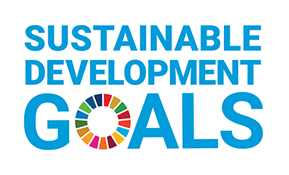

Monitoring fisheries catch is related to Sustainable Development Goal 14 (Life Below Water) and more specifically to target 14.4:
By 2020, effectively regulate harvesting and end overfishing, illegal, unreported and unregulated fishing and destructive fishing practices and implement science-based management plans, in order to restore fish stocks in the shortest time feasible, at least to levels that can produce maximum sustainable yield as determined by their biological characteristics.
This international target has been incorporated into the 2022–26 Federal Sustainable Development Strategy as part of Canada’s commitment to conserving and protecting its oceans.
Visit our Sustainable Development page to learn more about sustainable development and the Office of the Auditor General of CanadaOAG.
Exhibit highlights
Fisheries and Oceans Canada’s annual cycle for fisheries management
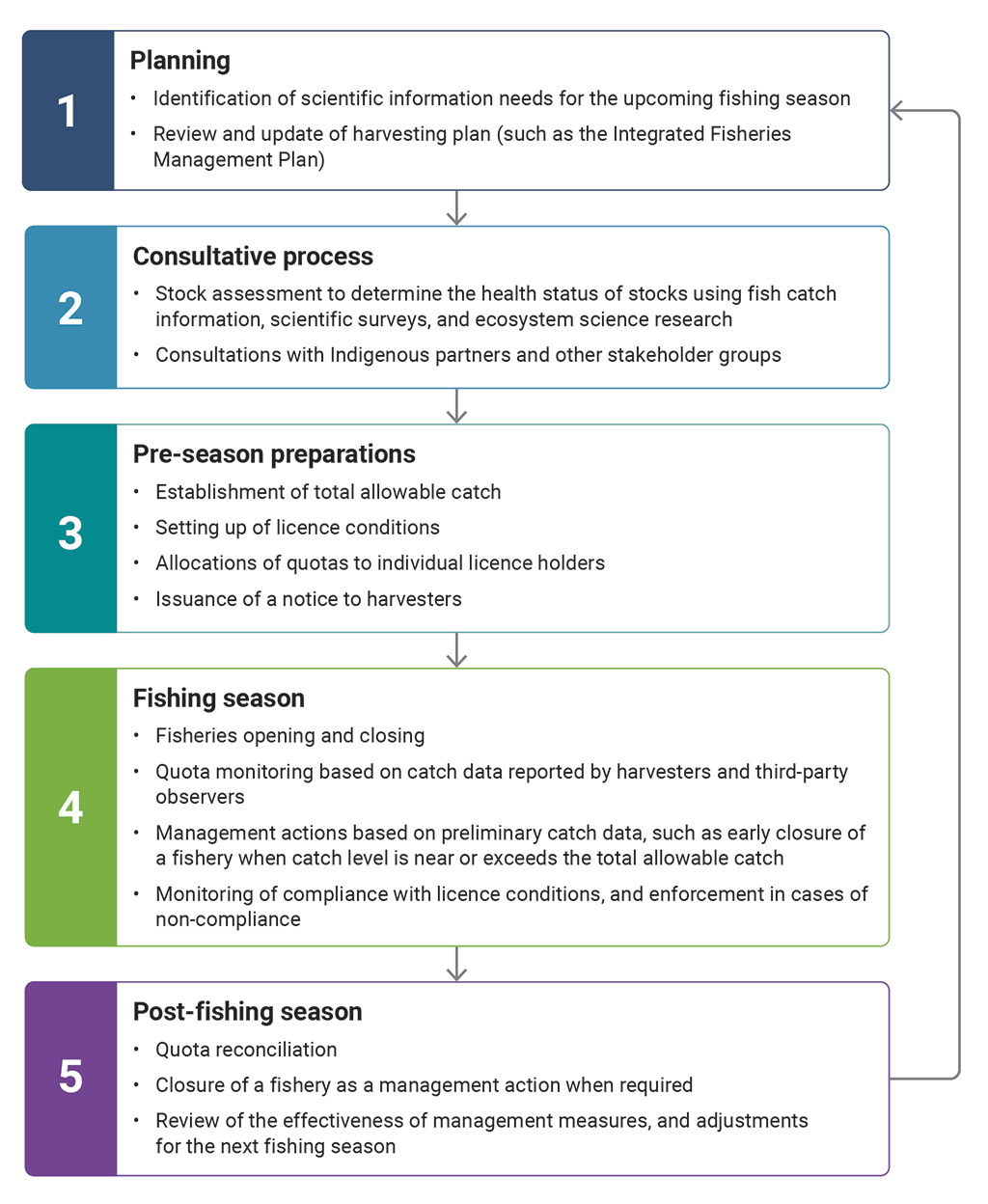
Source: Based on information provided by Fisheries and Oceans Canada
Text version
This chart shows the 5 steps of Fisheries and Oceans Canada’s annual cycle for fisheries management.
Step 1 is planning, which includes the following:
- Identification of scientific information needs for the upcoming fishing season
- Review and update of harvesting plan (such as the Integrated Fisheries Management Plan)
Step 2 is the consultative process, which includes the following:
- Stock assessment to determine the health status of stocks using fish catch information, scientific surveys, and ecosystem science research
- Consultations with Indigenous partners and other stakeholder groups
Step 3 is pre-season preparations, which include the following:
- Establishment of total allowable catch
- Setting up of licence conditions
- Allocations of quotas to individual licence holders
- Issuance of a notice to harvesters
Step 4 is the fishing season, which includes the following:
- Fisheries opening and closing
- Quota monitoring based on catch data reported by harvesters and third-party observers
- Management actions based on preliminary catch data, such as early closure of a fishery when catch level is near or exceeds the total allowable catch
- Monitoring of compliance with licence conditions, and enforcement in cases of non-compliance
Step 5 is the post-fishing season, which includes the following:
- Quota reconciliation
- Closure of a fishery as a management action when required
- Review of the effectiveness of management measures, and adjustments for the next fishing season
The next annual cycle begins with step 1 again.
As of December 2022, none of the fish stocks had undergone more than an assessment of current monitoring requirements
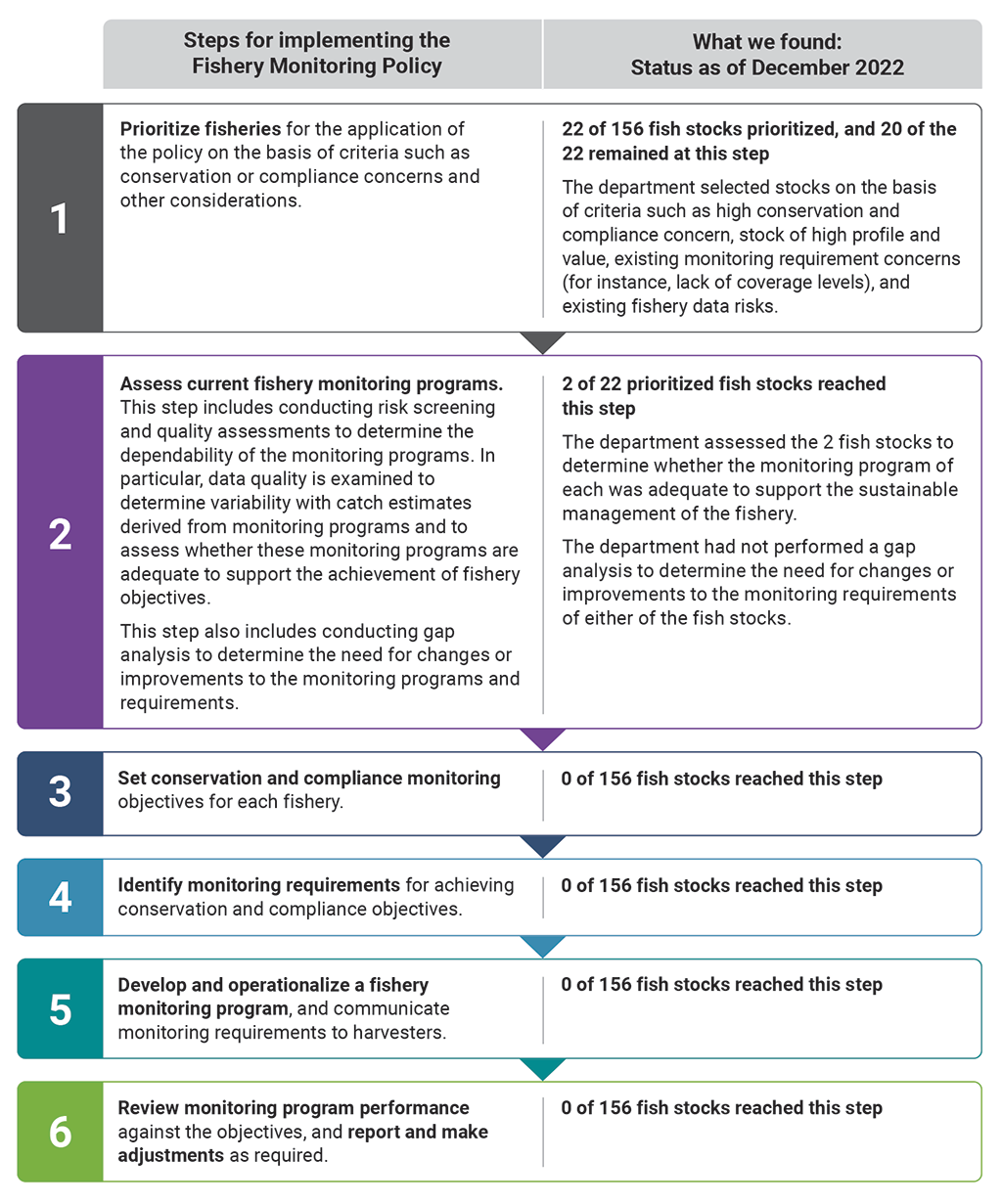
Source: Based on our analysis of information from Fisheries and Oceans Canada, including Introduction to the Procedural Steps for Implementing the Fishery Monitoring Policy, Fisheries and Oceans Canada, 2019
Text version
The following table shows the 6 steps for implementing Fisheries and Oceans Canada’s Fishing Monitoring Policy and the status that we found of each step as of December 2022.
| Step number | Steps for implementing the Fishery Monitoring Policy | What we found: Status as of December 2022 |
|---|---|---|
|
1 |
Prioritize fisheries for the application of the policy on the basis of criteria such as conservation or compliance concerns and other considerations. |
22 of 156 fish stocks prioritized, and 20 of the 22 remained at this step The department selected stocks on the basis of criteria such as high conservation and compliance concern, stock of high profile and value, existing monitoring requirement concerns (for instance, lack of coverage levels), and existing fishery data risks. |
|
2 |
Assess current fishery monitoring programs. This step includes conducting risk screening and quality assessments to determine the dependability of the monitoring programs. In particular, data quality is examined to determine variability with catch estimates derived from monitoring programs and to assess whether these monitoring programs are adequate to support the achievement of fishery objectives. This step also includes conducting gap analysis to determine the need for changes or improvements to the monitoring programs and requirements. |
2 of 22 prioritized fish stocks reached this step The department assessed the 2 fish stocks to determine whether the monitoring program of each was adequate to support the sustainable management of the fishery. The department had not performed a gap analysis to determine the need for changes or improvements to the monitoring requirements of either of the fish stocks. |
|
3 |
Set conservation and compliance monitoring objectives for each fishery. |
0 of 156 fish stocks reached this step |
|
4 |
Identify monitoring requirements for achieving conservation and compliance objectives. |
0 of 156 fish stocks reached this step |
|
5 |
Develop and operationalize a fishery monitoring program, and communicate monitoring requirements to harvesters. |
0 of 156 fish stocks reached this step |
|
6 |
Review monitoring program performance against the objectives, and report and make adjustments as required. |
0 of 156 fish stocks reached this step |
Coverage targets were not met in 2021 for many fish stocks subject to dockside monitoring
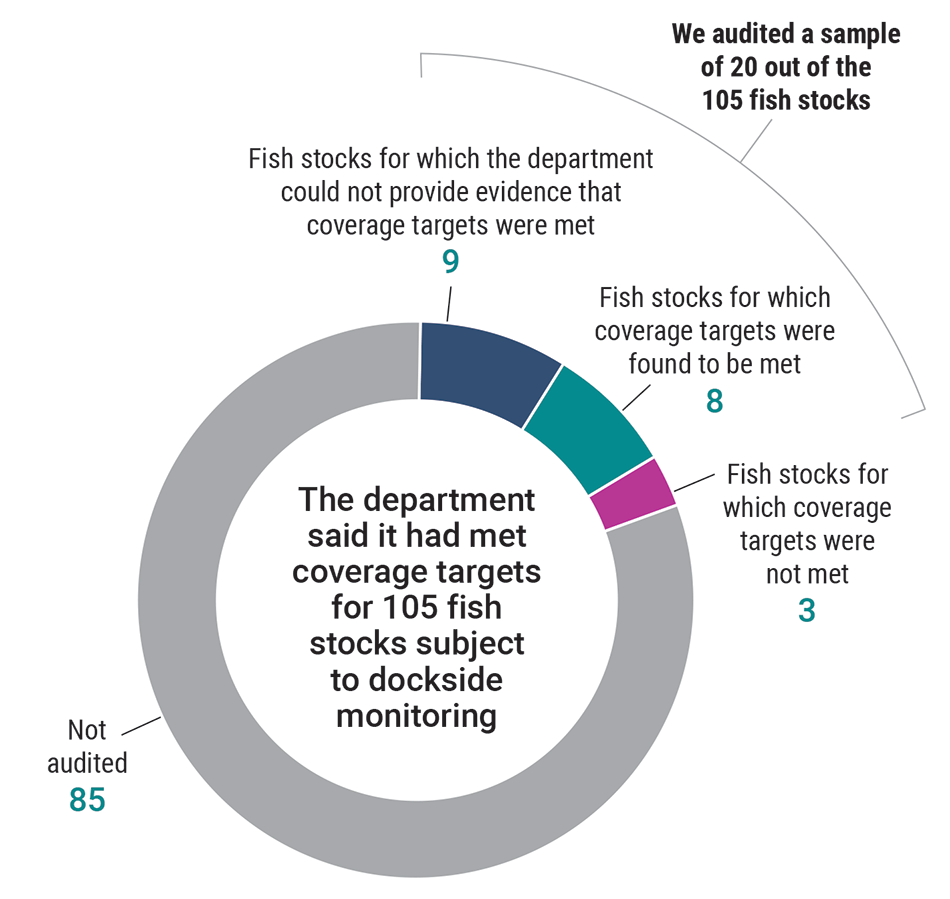
Source: Based on our analysis of information from Fisheries and Oceans Canada
Text version
This chart shows to what extent coverage targets were met in 2021 for fish stocks subject to dockside monitoring.
Fisheries and Oceans Canada said it had met coverage targets for 105 fish stocks subject to dockside monitoring.
We audited a sample of 20 out of the 105 fish stocks. Of the sample of 20 stocks, there were 9 for which the department could not provide evidence that coverage targets were met, there were 8 for which coverage targets were found to be met, and there were 3 for which coverage targets were not met. The remaining 85 out of the 105 fish stocks were not audited.
Timeliness requirements were not met in 2021 for many fish stocks subject to dockside monitoring
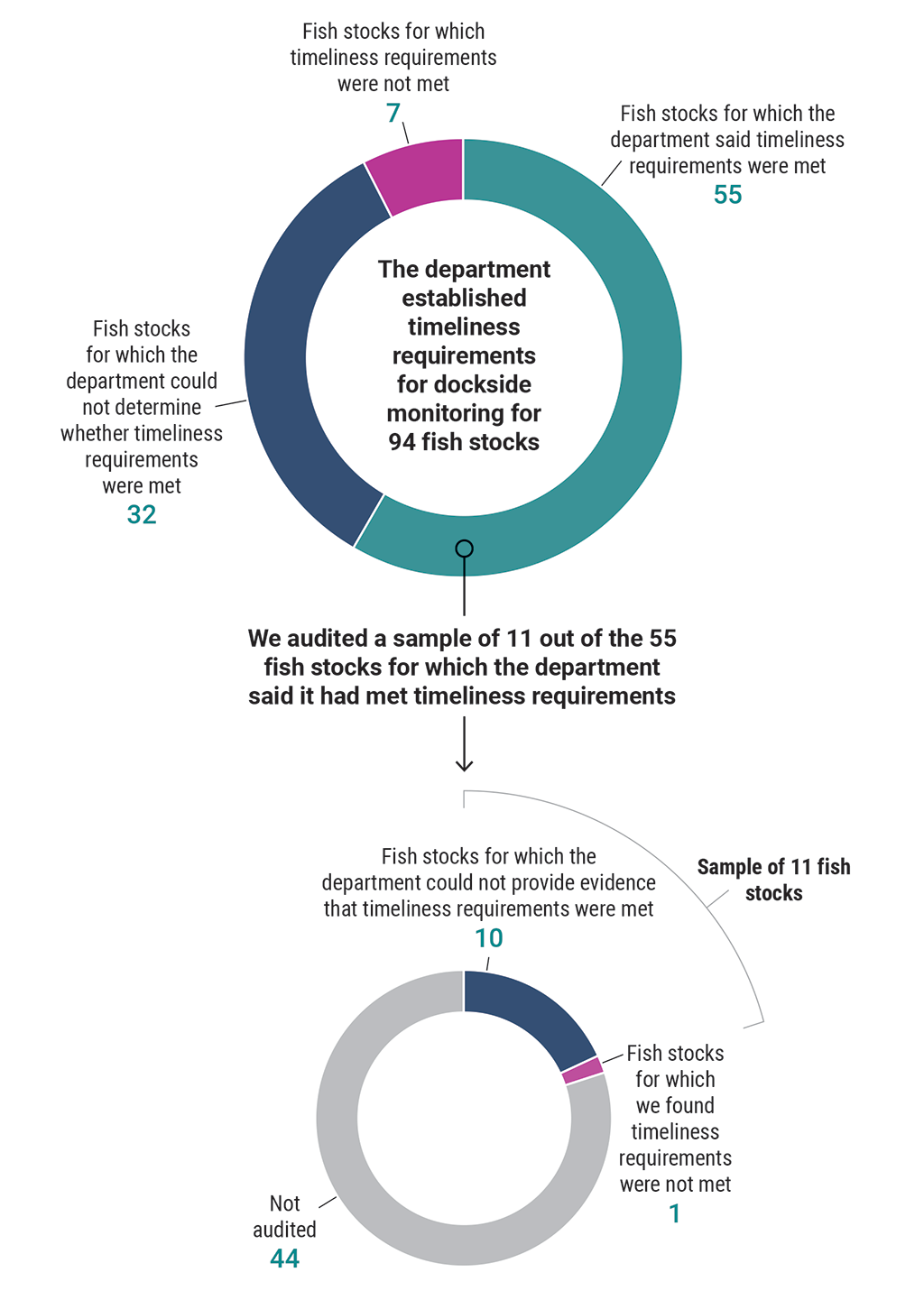
Source: Based on our analysis of information from Fisheries and Oceans Canada
Text version
This chart shows to what extent timeliness requirements were met in 2021 for fish stocks subject to dockside monitoring.
Fisheries and Oceans Canada established timeliness requirements for dockside monitoring for 94 fish stocks. Of these 94 fish stocks, there were 55 for which the department said timeliness requirements were met, there were 32 for which the department could not determine whether timeliness requirements were met, and there were 7 for which timeliness requirements were not met.
We audited a sample of 11 out of the 55 fish stocks for which the department said it had met timeliness requirements. Of the sample of 11 stocks, there were 10 for which the department could not provide evidence that timeliness requirements were met, and there was 1 for which we found timeliness requirements were not met. The remaining 44 out of the 55 fish stocks were not audited.
Related information
Entities
Tabling date
- 7 November 2023
Related audits
- 2022 Reports 6 to 10 of the Auditor General of Canada to the Parliament of Canada
Report 7—Protecting Aquatic Species at Risk - 2016 Fall Reports of the Commissioner of the Environment and Sustainable Development
Report 2—Sustaining Canada’s Major Fish Stocks—Fisheries and Oceans Canada
Parliamentary hearings
